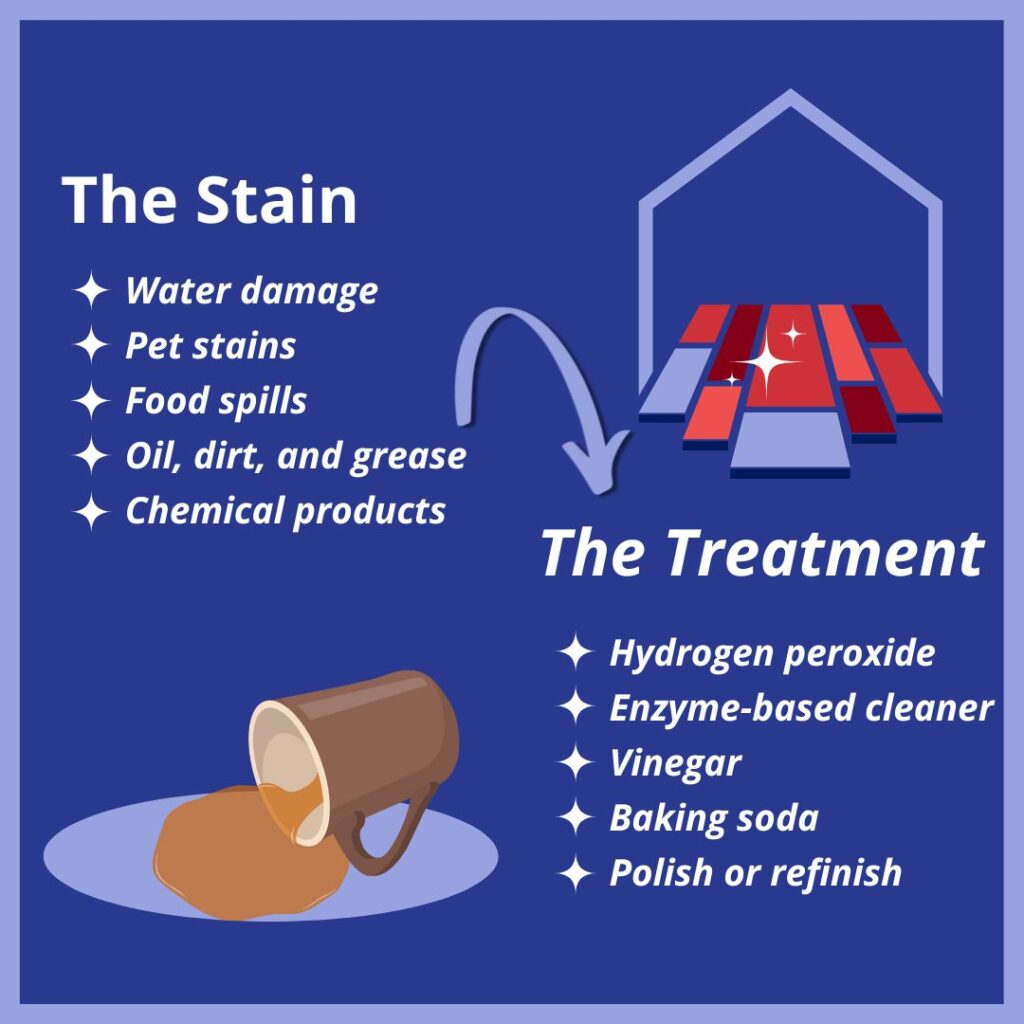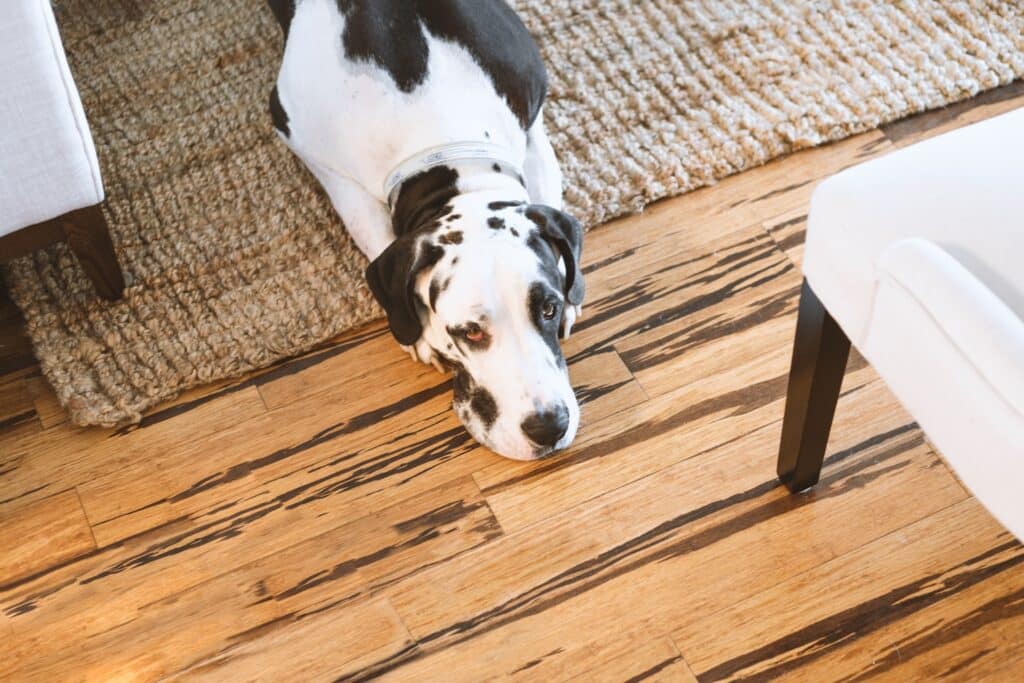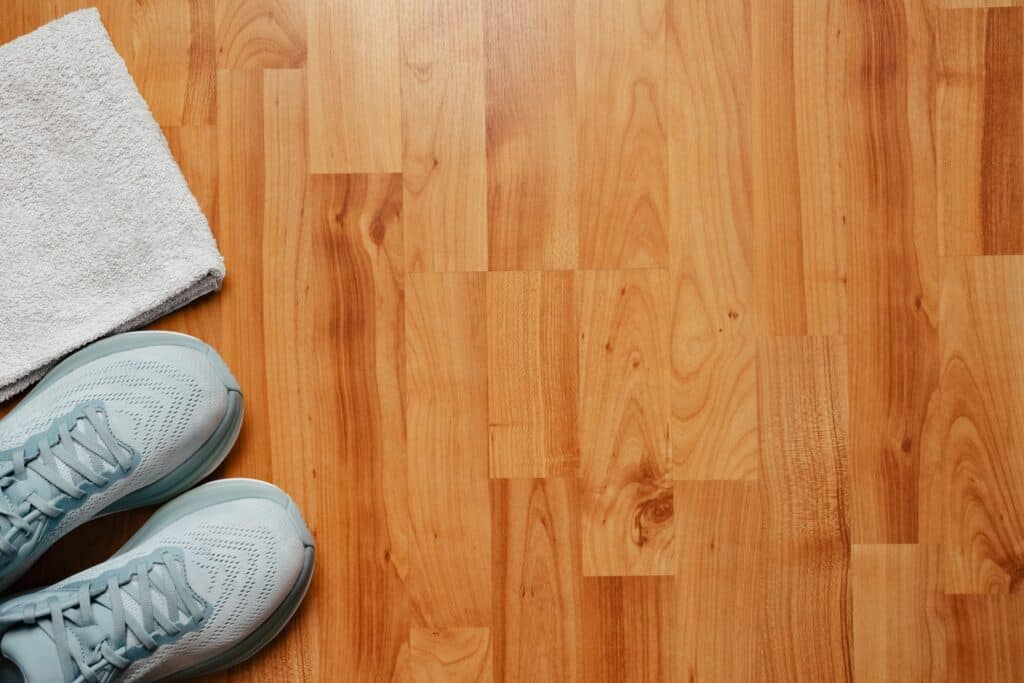Hardwood floor is tough, but stains have a way of making them look worn and neglected. A dark water ring, a stubborn grease spot, or a pet accident that won’t fade—each stain tells a story, and some are easier to erase than others.
The trick isn’t just knowing how to remove stains but understanding what caused them in the first place. Some stains are surface-level and clean up with a little effort, while others soak deep into the wood and come along with damage that shouldn’t be ignored.
What Causes Hardwood Floor Stains?
Stains on hardwood floors aren’t just a cosmetic issue—they’re a sign that something has seeped into the wood or its finish.
Knowing what caused the stain helps determine the best way to remove it and whether there’s underlying damage to address.
- Water exposure from spills, pet accidents, or high humidity
- Food and drink spills like coffee, wine, or sauces
- Oil-based stains from cooking grease, lotions, or makeup
- Chemical damage from harsh cleaners or DIY treatments
- Dirt and grime buildup in high-traffic areas

Identifying and Removing Common Hardwood Floor Stains
Not all stains are the same, and using the wrong cleaning method can make things worse. Some stains sit on the surface, while others soak deep into the wood, leaving behind damage that may require refinishing. Here’s how to handle the most common types of hardwood floor stains and remove them safely.
Water Stains
Water stains are some of the most common issues homeowners face, often appearing after spills, pet accidents, or humidity exposure.
- White or cloudy stains mean moisture is trapped in the finish
- Dark stains indicate water has penetrated into the wood
To remove white stains, buff the area with a soft cloth and a small amount of mineral oil. If the stain persists, a mixture of baking soda and water can help lift it. Dark stains may require more aggressive treatment, such as applying hydrogen peroxide or refinishing the affected area.
Pets
Pet accidents can leave behind more than just stains—urine and other messes can seep into the wood, causing discoloration and lingering odors.
- Fresh stains should be blotted up immediately to prevent absorption
- Enzyme-based cleaners work best for breaking down pet-related stains and odors
- For set-in stains, applying a mixture of hydrogen peroxide and water can help lighten discoloration
If pet stains have penetrated deep into the wood, sanding and refinishing may be necessary to fully restore the flooring.
Food and Beverage Stains
Spilled coffee, wine, or juice can leave noticeable stains, especially on lighter wood finishes.
- Wipe up spills immediately with a damp microfiber cloth
- A mild vinegar and water solution can help lift surface stains
- For stubborn stains, a baking soda paste can be applied, left to sit, and gently scrubbed away
Dark stains from acidic beverages may require additional treatments, such as applying hydrogen peroxide, to fully restore the wood’s natural color.
Oil and Grease Stains
Oils from cooking, lotions, or cosmetics can leave behind dark, slick spots that are difficult to remove.
- Sprinkle baking soda or cornstarch over the stain to absorb excess oil
- Let the powder sit for several hours before sweeping it up
- Wipe the area with a mild dish soap solution to break down any remaining residue
If grease has penetrated deep into the wood, refinishing may be necessary to fully remove the stain.
Chemical and Cleaning Product Stains
Harsh cleaners, including ammonia and some DIY treatments, can cause discoloration and dull patches on hardwood floors.
- Avoid using strong chemicals that can strip the finish
- If discoloration occurs, apply a small amount of hardwood floor polish to restore shine
- Deep damage may require sanding and refinishing to even out the surface

Preventing Hardwood Floor Stains
The best way to deal with stains is to prevent them in the first place. Simple maintenance habits help keep hardwood floors looking their best and protect them from deep-set damage.
- Clean spills immediately – The longer liquids sit, the more likely they are to seep into the wood.
- Use protective mats and rugs – Place them in high-traffic areas, near doorways, and under pet food bowls to minimize exposure to dirt, water, and spills.
- Choose the right cleaners – Harsh chemicals can strip the finish and leave floors vulnerable to staining. Stick to pH-neutral cleaners made for hardwood.
- Control indoor humidity – Excess moisture can lead to water stains and warping. A dehumidifier can help in humid climates.
- Apply a protective sealant – A well-maintained finish creates a barrier against stains, making cleanup easier.
Other Recommended Maintenance
In addition to stain prevention, consider these maintenance steps:
- Sweep or vacuum regularly to prevent dirt buildup that can scratch the finish.
- Avoid excessive water when cleaning—damp mopping is best.
- Check for leaks around appliances, windows, and plumbing that could lead to water stains.
- Reapply sealant as needed to keep floors protected from moisture and wear.
When to Call a Professional
Some stains aren’t just cosmetic. If they keep reappearing, won’t come out despite multiple cleaning attempts, or are paired with signs of moisture damage, a professional inspection may be necessary.
Consider calling for help if you notice:
- Recurring water stains that could indicate leaks, high humidity, or hidden moisture problems.
- Dark, spreading stains near walls, baseboards, or windows that may be linked to structural issues.
- Soft, warped, or discolored flooring that suggests prolonged water exposure or mold growth.
- Stains appearing in multiple areas—this could point to a larger underlying issue with your home’s plumbing, foundation, or ventilation.
An inspector can help determine whether the stain is a sign of a bigger problem, such as a slow plumbing leak, poor drainage, or improper sealing.
Conclusion
While many stains can be cleaned up with the right method, others keep coming back, hinting at deeper problems like moisture damage, leaks, or poor ventilation. The sooner these issues are addressed, the better chance you have of preventing costly repairs down the road.
If stubborn discoloration or warping has you questioning what’s going on beneath the surface, America’s Choice Inspections can help.


